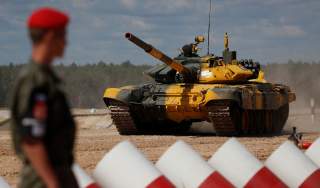Meet Russia's Railroad Troops (And Here Is Their New Mission)
Moscow is now planning to modernize its railway army—and dispatch it to Syria to rebuild that country’s railroads.
Many armies have unique organizations. France has its Foreign Legion, America has that mini-army known as the Marine Corps—and Russia has its Railroad Troops.
Charged with building and maintaining railways, the Railroad Troops seem to be somewhere between a military organization and an agency like the U.S. Army Corps of Engineers, a non-combat institution that frequently builds public infrastructure. Russia’s Railroad Troops have about 29,000 personnel, organized into four corps comprising ten separate brigades, according to the U.S. Army’s Foreign Military Studies Office. The railroad brigades include several types of battalions needed to build and maintain railroads, including bridging and repair units. In another uniquely Russian touch, they are charged with operating several armored trains stationed in southern Russia.
Russia is now planning to modernize its railway army—and dispatch it to Syria to rebuild that country’s railroads.
That’s quite a turnaround for a force that was nearly dissolved after the Cold War. “In the course of the reforms of the end of the last decade, the status and role of military railway workers were noticeably reduced and even the option of completely abandoning them was considered,” according to Russian newspaper Izvestia. One reason the Railroad Troops were not disbanded was their work during the Ukraine conflict.
“After the beginning of the armed conflict in the south-east of Ukraine in 2014, the railway troops were entrusted with the task of national importance—to ensure the construction of a railway branch bypassing the territory of Ukraine,” Izvestia said. “The section Zhuravka-Millerovo was completed ahead of schedule. The contribution of the railway soldiers to the construction of ways to bypass the Ukrainian territory was one of the reasons why it was decided to increase the role of this kind of troops.”
Syria is likely to be next, Alexander Plendzhiev, associate professor of the Plekhanov Russian University of Economics, told Izvestia. “After the victory of Syrian government troops over the militants, the most pressing issue will be the issue of post-war restoration of the republic. Railway communications are of great importance for this country. The possibility of the participation of the Russian railway troops in the construction and rehabilitation of railways is being considered.”
In addition, the Railroad Troops may support Russia’s buildup in the Arctic. “Another task that may be assigned to railway workers is the construction of separate [railroad] branches to the circumpolar facilities located in the zone of responsibility of the Arctic command,” Izvestia said. “Military forces can build such paths much faster, cheaper and more efficiently.”
“The functionality and technical capabilities of the railway troops will be significantly expanded,” said Izvestia, citing Russia’s Ministry of Defense. “Their tasks will include not only providing transportation, but also rescue operations in emergency situations and disasters. Now the newest models of special equipment—all-terrain vehicles, amphibians, self-propelled pontoons, etc., will arrive at the railroad connections. By 2020, the troops will have been completely re-equipped.”
Russia’s Railway Troops have always been a bit of an anomaly. During the Cold War, when U.S. intelligence estimates depicted the Soviet Army as an enormous force, some questioned whether railroad builders should be counted alongside regular military units. Today’s Railroad Troops are 60 percent conscripts and 40 percent volunteers, according to Lieutenant General Oleg Kosenkov, chief of the Railway Troops, in an interview with the military newspaper Krasnaya Zvezda (Google English translation here).
In an era of air travel, superhighways and soon self-driving cars, military railroad soldiers seem like an anachronism, a throwback to the days of the Tsar and locomotives slowly steaming through Siberian tundra. But Kosenkov emphasized how important railroads are to Russia, a nation so vast that it stretches across eleven time zones, from the Atlantic to the Pacific.
“The main type of delivery of materiel and personnel in our country is still rail transport. Military transport aviation will not deliver as many troops and cargo as it was on the railways. It will solve the tasks of rapid response, but mainly the redeployment of troops is carried out by rail.”
Michael Peck is a contributing writer for the National Interest. He can be found on Twitter and Facebook.
Image: Reuters

